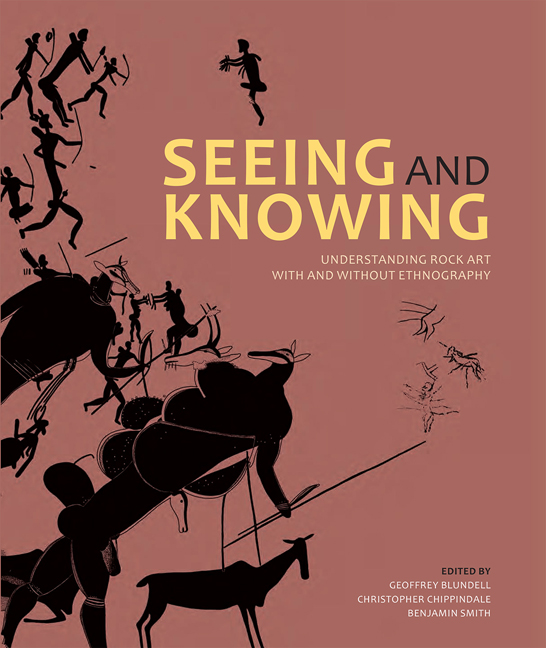Book contents
- Frontmatter
- Dedication
- Contents
- Contributors
- Acronyms
- Chapter 1 Rock art with and without ethnography
- Chapter 2 Flashes of brilliance: San rock paintings of heaven's things
- Chapter 3 Snake and veil: The rock engravings of Driekopseiland, Northern Cape South Africa
- Chapter 4 Cups and saucers: A preliminary investigation of the rock carvings of Tsodilo Hills, northern Botswana
- Chapter 5 Art and authorship in southern African rock art: Examining the Limpopo-Shashe Confluence Area
- Chapter 6 Archaeology, ethnography, and rock art: A modern-day study from Tanzania
- Chapter 7 Art and belief: The ever-changing and the never-changing in the Far west
- Chapter 8 Crow Indian elk love-medicine and rock art in Montana and Wyoming
- Chapter 9 Layer by layer: Precision and accuracy in rock art recording and dating
- Chapter 10 From the tyranny of the figures to the interrelationship between myths, rock art and their surfaces
- Chapter 11 Composite creatures in European Palaeolithic art
- Chapter 12 Thinking strings: On theory, shifts and conceptual issues in the study of Palaeolithic art
- Chapter 13 Rock art without ethnography? A history of attitude to rock art and landscape at Frøysjøen, western norway
- Chapter 14 ‘Meaning cannot rest or stay the same’
- Chapter 15 Manica rock art in contemporary society
- Chapter 16 Oral tradition, ethnography, and the practice of north American archaeology
- Chapter 17 Beyond rock art: Archaeological interpretation and the shamanic frame
- List of figures
- List of tables
- List of publications by david Lewis-williams
- Index
Chapter 8 - Crow Indian elk love-medicine and rock art in Montana and Wyoming
Published online by Cambridge University Press: 21 April 2018
- Frontmatter
- Dedication
- Contents
- Contributors
- Acronyms
- Chapter 1 Rock art with and without ethnography
- Chapter 2 Flashes of brilliance: San rock paintings of heaven's things
- Chapter 3 Snake and veil: The rock engravings of Driekopseiland, Northern Cape South Africa
- Chapter 4 Cups and saucers: A preliminary investigation of the rock carvings of Tsodilo Hills, northern Botswana
- Chapter 5 Art and authorship in southern African rock art: Examining the Limpopo-Shashe Confluence Area
- Chapter 6 Archaeology, ethnography, and rock art: A modern-day study from Tanzania
- Chapter 7 Art and belief: The ever-changing and the never-changing in the Far west
- Chapter 8 Crow Indian elk love-medicine and rock art in Montana and Wyoming
- Chapter 9 Layer by layer: Precision and accuracy in rock art recording and dating
- Chapter 10 From the tyranny of the figures to the interrelationship between myths, rock art and their surfaces
- Chapter 11 Composite creatures in European Palaeolithic art
- Chapter 12 Thinking strings: On theory, shifts and conceptual issues in the study of Palaeolithic art
- Chapter 13 Rock art without ethnography? A history of attitude to rock art and landscape at Frøysjøen, western norway
- Chapter 14 ‘Meaning cannot rest or stay the same’
- Chapter 15 Manica rock art in contemporary society
- Chapter 16 Oral tradition, ethnography, and the practice of north American archaeology
- Chapter 17 Beyond rock art: Archaeological interpretation and the shamanic frame
- List of figures
- List of tables
- List of publications by david Lewis-williams
- Index
Summary
The Crow Indians of Montana recognise the power possessed by a variety of animals, among them grizzly bears, eagles, and bison, but the power of the American elk to control human love and passion exceeds that of any other species. Through recent research, I have learnt that rock art sites associated with elk love-magic may be a relatively common component of the rock art record in Montana and Wyoming.
LOVE-MAGIC AND THE AMERICAN ELK
The American elk (Cervus elaphus), known in northern Europe as the red deer, is a large Artiodactyla that was originally distributed across most of North America. An average mature bull elk weighs 700 lb (315 kg), stands 5 ft (1.5 m) at the shoulder, and measures more than 8 ft (2.4 m) from nose to rump; cows are about threequarters the size of bulls (Figure 8.1). Each spring, as the testosterone levels in their blood rise in response to increasing amounts of daylight, bull elk begin to grow antlers from the pedicles on their skulls. By September, the antlers are hard and fully developed, weighing as much as 40 lb (18 kg) per pair. Rising testosterone levels in bull elk throughout September also stimulate mating behaviours. Bulls emit a loud whistling bugle sound to attract cows and then must fight other males seeking access to their harem. Charging at one another and locking their massive antlers, bull elk repeatedly engage in duels of strength. The reproductive pay-off for a successful mature bull elk is that he might control as many as 40 or 50 cows throughout the rutting season.
American Indians across North America identified the elk as an important power animal. This association was especially prevalent among Plains Indians, in whose mythology, songs, and art the elk occupied a significant position. Among the Lakota, for example, the elk has been described as:
the emblem of beauty, gallantry, and protection. The elk lives in the forest and is in harmony with all his beautiful surroundings. He goes easily through the thickets, not-withstanding his broad branching horns. In observing the carcass of an elk it is found that two teeth remain after everything else has crumbled to dust. These teeth will last longer than the life of a man, and for that reason the elk tooth has become an emblem for long life (Densmore 1918: 176).
- Type
- Chapter
- Information
- Seeing and KnowingUnderstanding Rock Art With and Without Ethnography, pp. 138 - 147Publisher: Wits University PressPrint publication year: 2010



